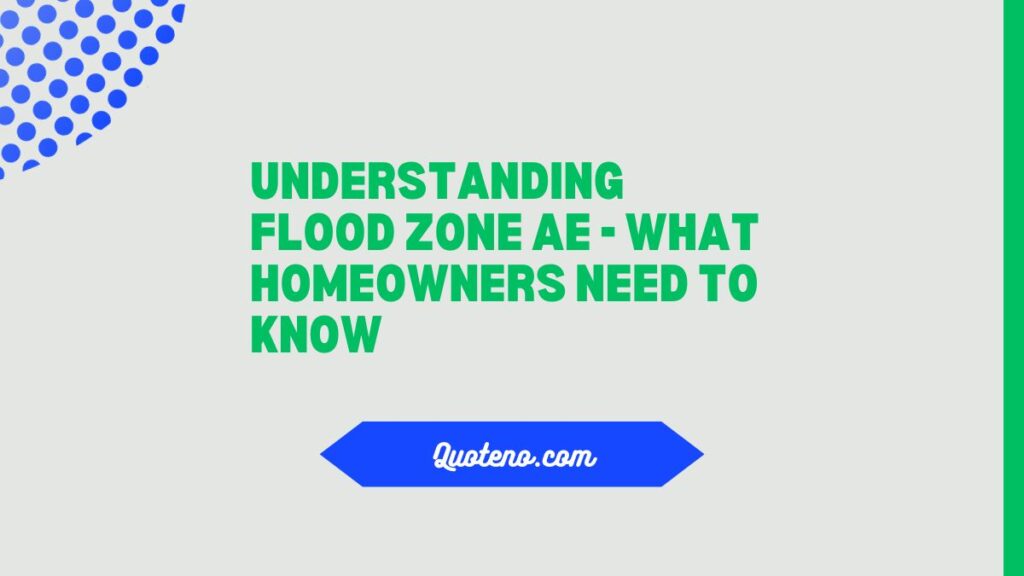Whether you’re considering buying a home in flood zone AE or planning a major renovation project in a flood-prone area, understanding your community’s flood zones and insurance requirements is essential. Especially since standard homeowners’ insurance doesn’t cover flood damage.
If your prospective property is in a riskier flood zone, you’ll likely need flood insurance through the NFIP. Here’s what you need to know about this process:
Table of Contents
The Base Flood Elevation (BFE)
When purchasing a home, there are many things homeowners need to consider. The location, the crime rate in the area, and the schools are good, and if it’s near any natural disasters such as floods. One of the most important factors for many is whether or not a home is in flood zone AE.
What is flood zone AE, and why is it so important? Well, flood zones are created by the Federal Emergency Management Agency (FEMA) to determine a community’s risk for flooding. When a property is in a flood zone, it means that it’s at some risk for flooding in the future and that you’ll likely need flood insurance.
FEMA also uses maps to identify which areas are in a flood zone. This is important because it helps communities establish regulations regarding building and development near bodies of water and set insurance rates.
For example, homes in flood zone AE must carry flood insurance if mortgaged with a federally-backed lender. This is because properties in this flood zone have a higher risk of flooding and are more likely to be affected than those in other areas. When determining home owner’s insurance rates, insurers consider the flood zone and other factors such as age and construction of the home.
The 100-Year Floodplain
Flooding is one of the most destructive and costly natural disasters homeowners face. Just an inch of water can damage a home and cost $25,000 in repairs. FEMA estimates that homes located in flood zones are at a higher risk for flooding than those not in the zone. That’s why knowing your flood zone before buying a house is important.
FEMA assigns each property to a flood zone on an FIRM map using information about the chance of flooding. It accounts for factors like elevation, distance from the nearest body of water, and potential storm surge. However, many people need clarification on determining a home’s flood zone.
Specifically, a home is classified as being in a flood zone if it’s in the 100-year Floodplain or flood zone AE. It’s also known as a special flood hazard area and presents around a 26% chance of flooding over the life of a 30-year mortgage.
Unlike other FEMA-designated flood zones, the base flood elevations (BFE) and floodways aren’t shown in AE areas. This means it’s harder to understand the real risk of a flood occurring in these zones than others. Because of this, AE zone homes are generally considered the most at-risk and must have mandatory flood insurance. This doesn’t mean that a home can’t be in the zone, but it does mean that the lowest floors and all electrical, plumbing, and HVAC must be above the BFE to avoid flood damage.
The Special Flood Hazard Area (SFHA)
Homeowners buying a home in a flood zone must take extra precautions to protect their property. Flooding is one of the most destructive and costly natural disasters; even just an inch of water can cause $25,000 in damage. Knowing your home’s flood zone can help you better understand your risk level and impact on your mortgage, insurance policies, and resale value.
The federally backed National Flood Insurance Program (NFIP) provides flood insurance to owners of properties in communities that participate in the program. NFIP’s flood zones identify areas with a greater risk of flooding and are typically located near bodies of water like rivers and lakes.
Flood zones are mapped on FEMA’s Flood Insurance Rate Maps (FIRMs), and a darkly shaded area represents the SFHA. In the past, these flood zones were used in determining your property’s flood insurance premium. However, since the introduction of the new NFIP Risk Rating 2.0, these zones are more of a regulatory measurement determining whether you need to carry a flood policy.
Generally, homes in an SFHA will be located in Zone A, Zone AO, Zone AH or Zone AE on a FIRM. The reference points for a policy will differ depending on the zone, but all zones have a 1% or higher chance of flooding in a 30-year mortgage term.
The Flood Insurance Rate Map (FIRM)
In general, properties mapped into flood zone AE have around a 26% chance of flooding over the 30-year life of a mortgage. This means that if you’re in this zone, it’s likely that your mortgage will require you to have flood insurance.
Historically, a home’s flood zone has been one of the main factors in determining its insurance rates. However, with the change to Risk Rating 2.0, it needs to be clarified what impact flood zones will have on homeowners’ rates in the future.
As a rule of thumb, the higher the flood zone number, the more expensive your premium will be. This is because the BFE on a FIRM is referenced to a vertical datum, not your home’s ground elevation. For this reason, it’s important to keep your valuable items elevated well above the BFE in your home. This will not only protect your belongings, but it can also help prevent mold and other hazards from affecting your health.

